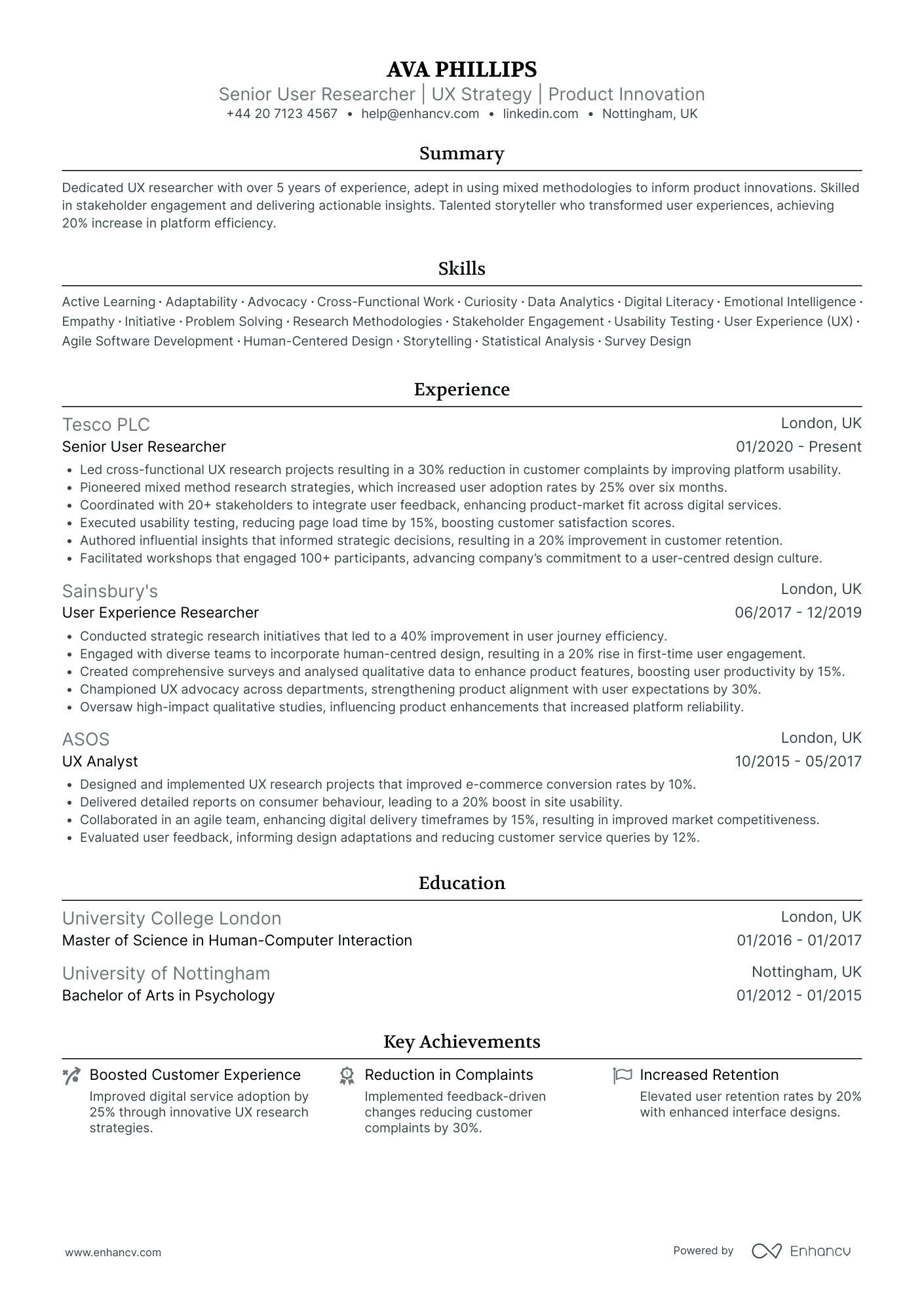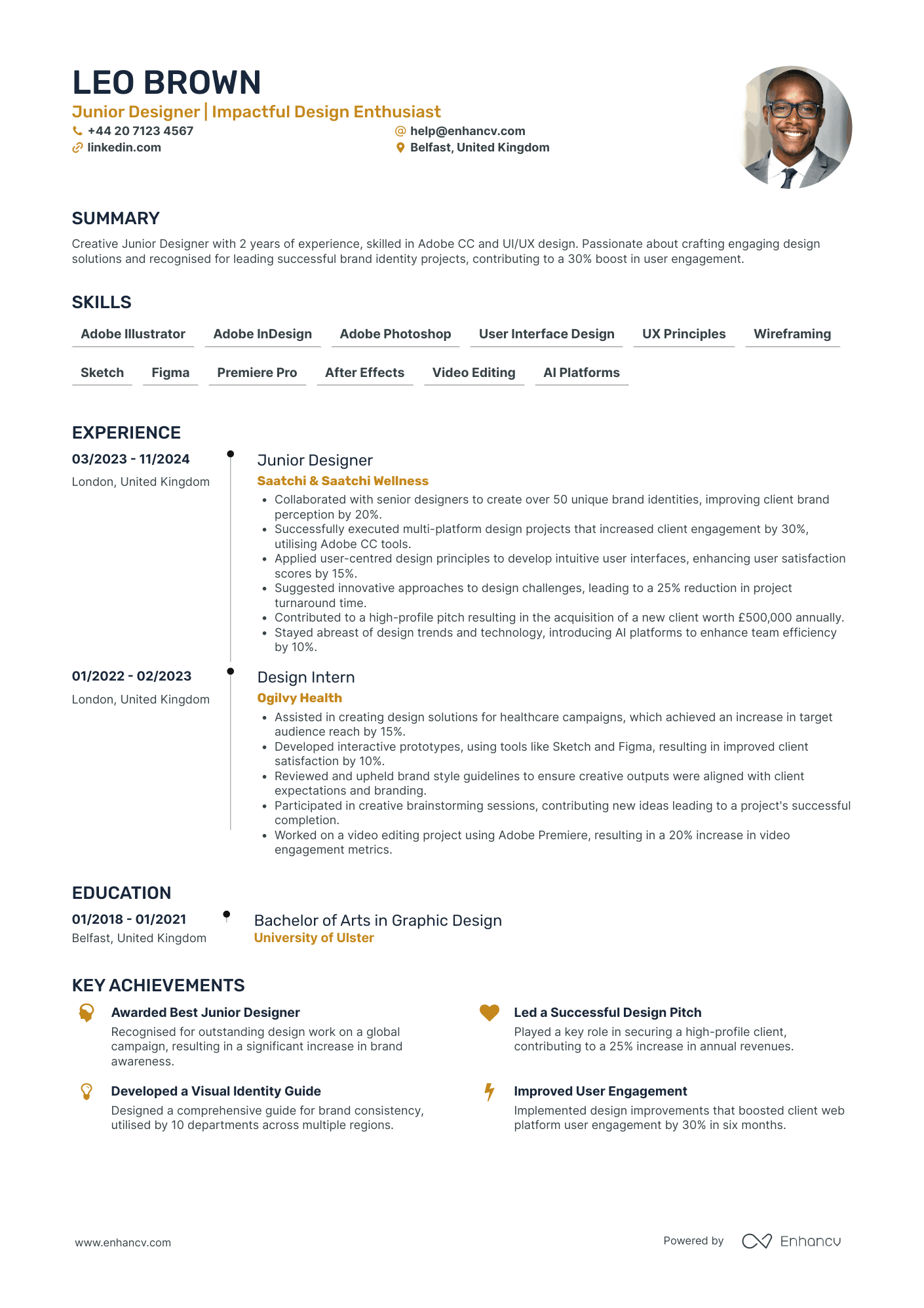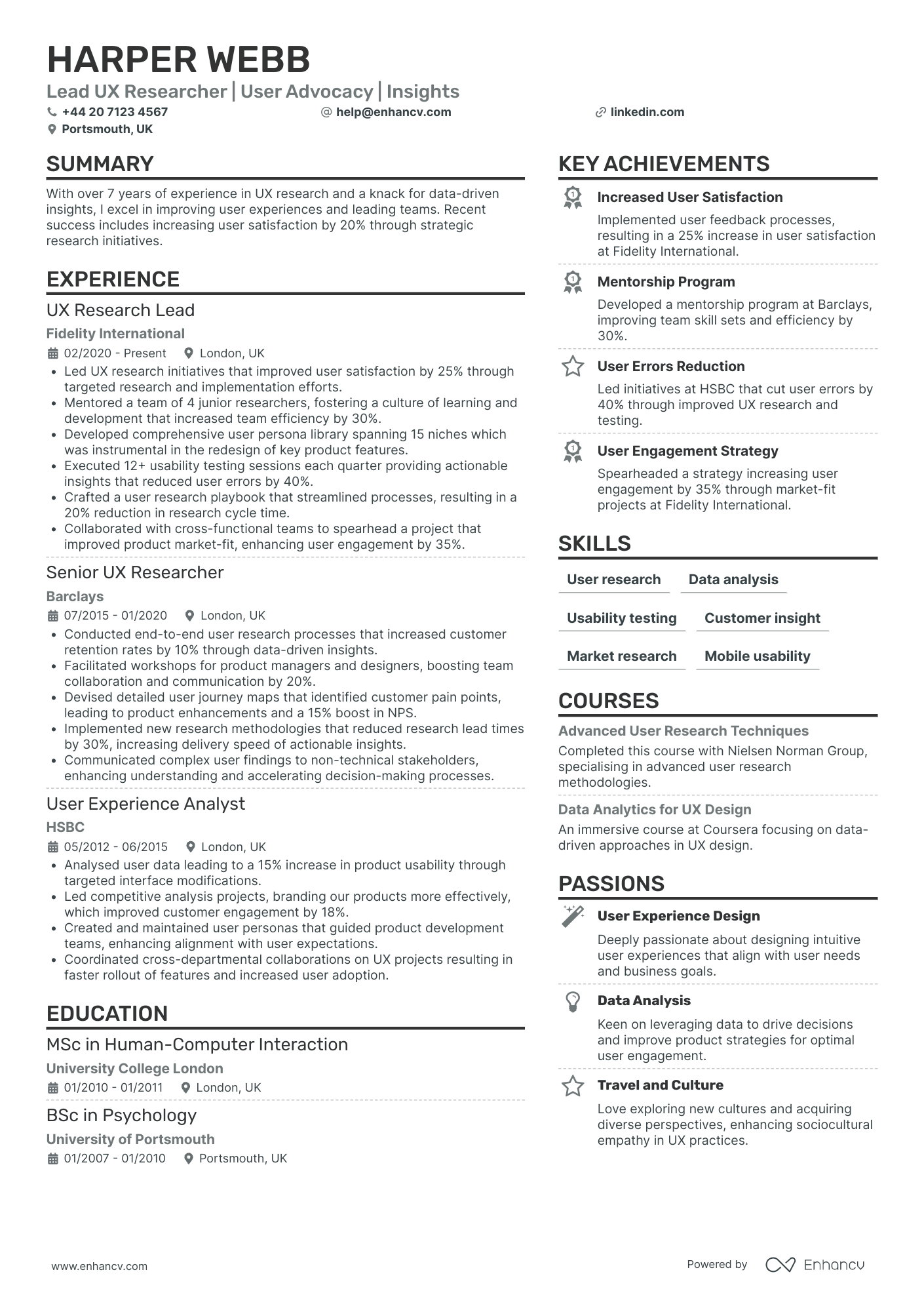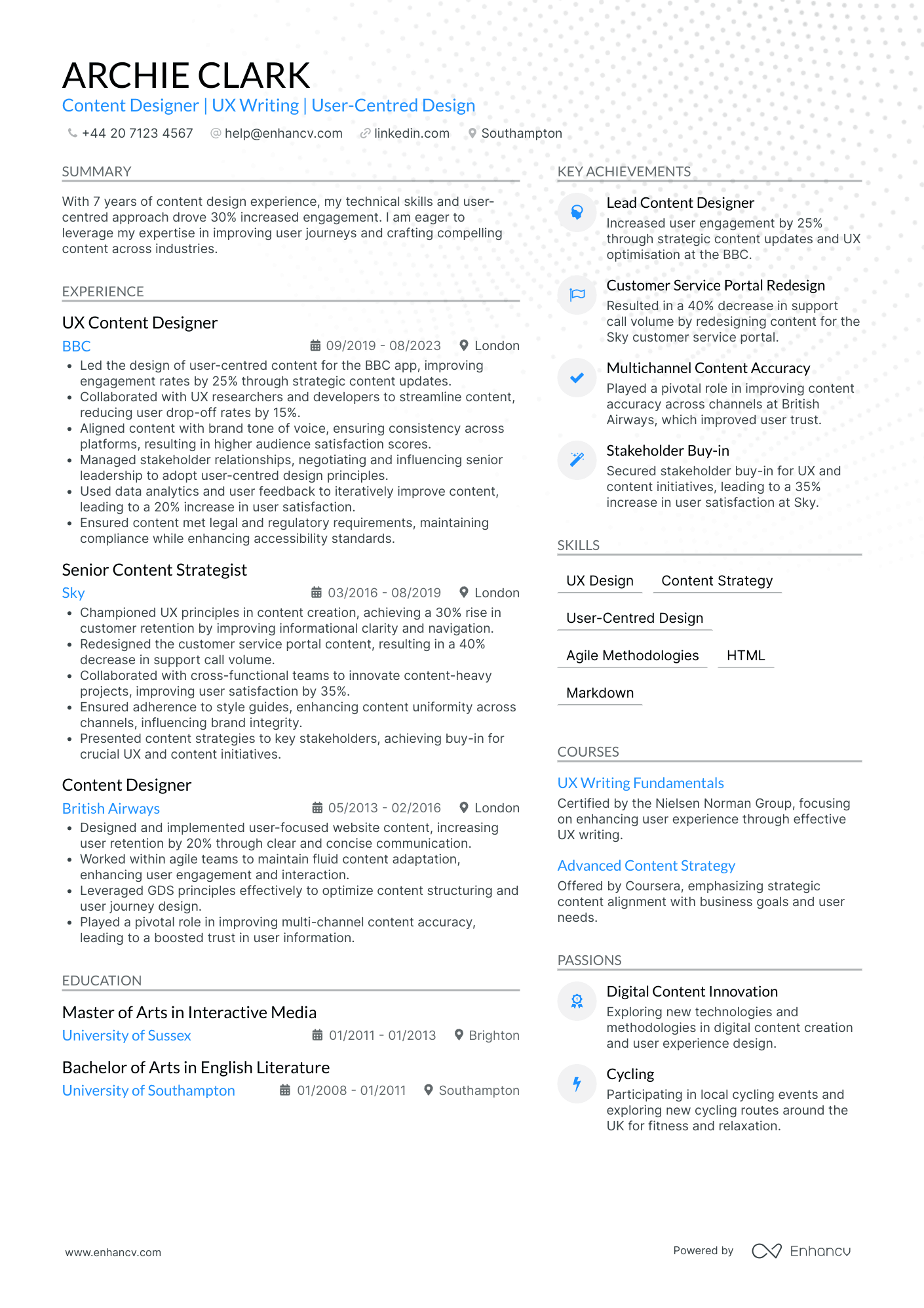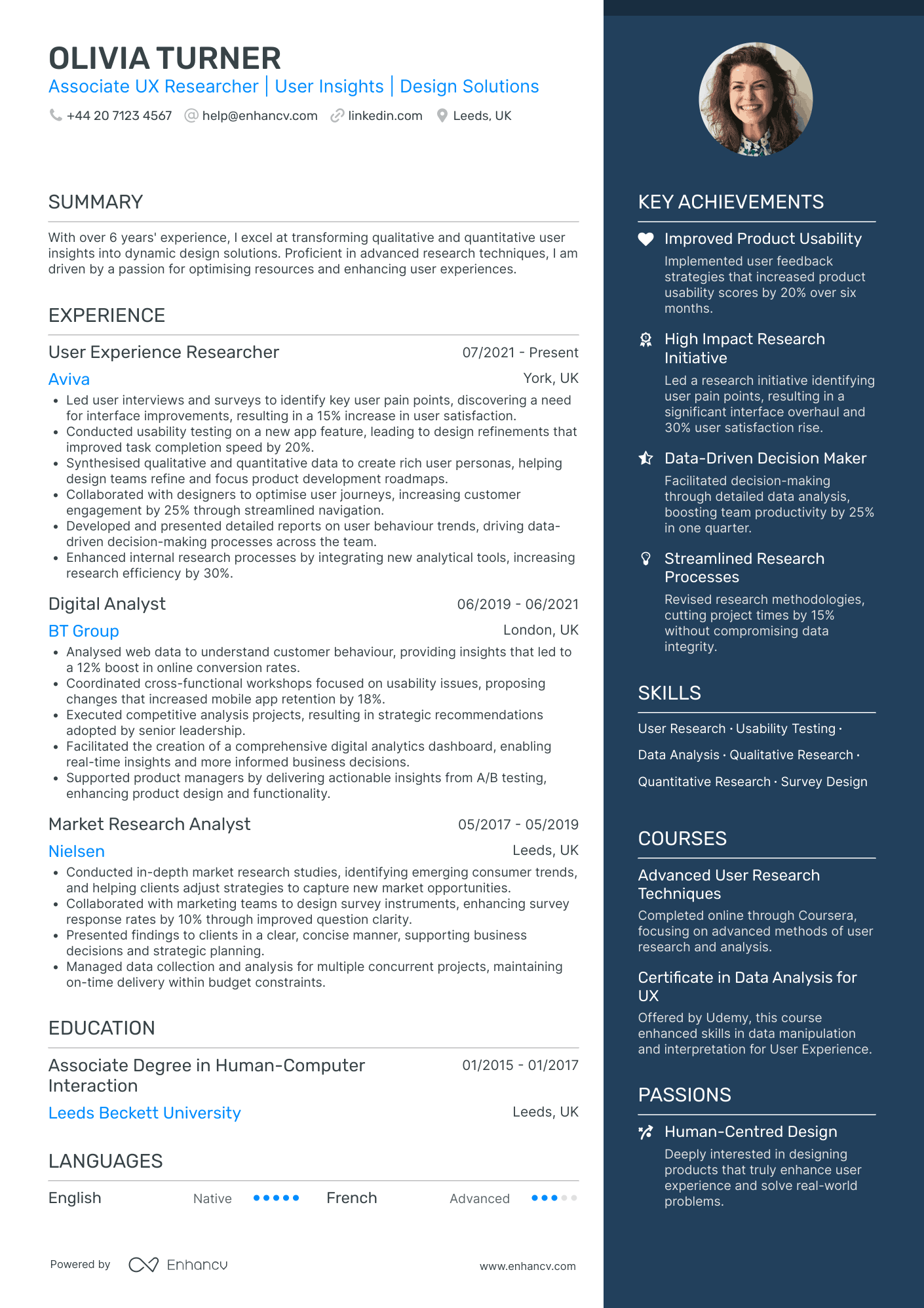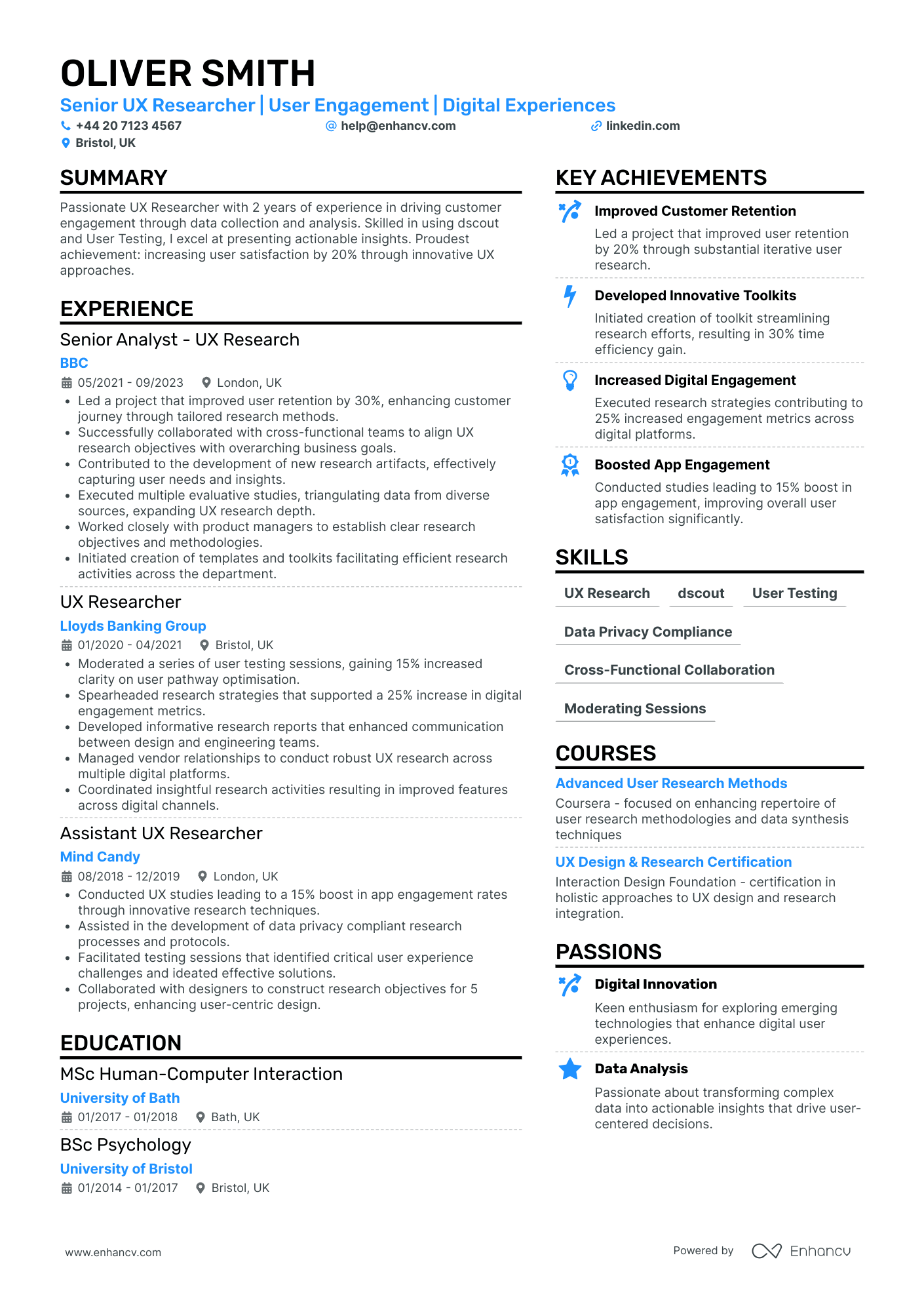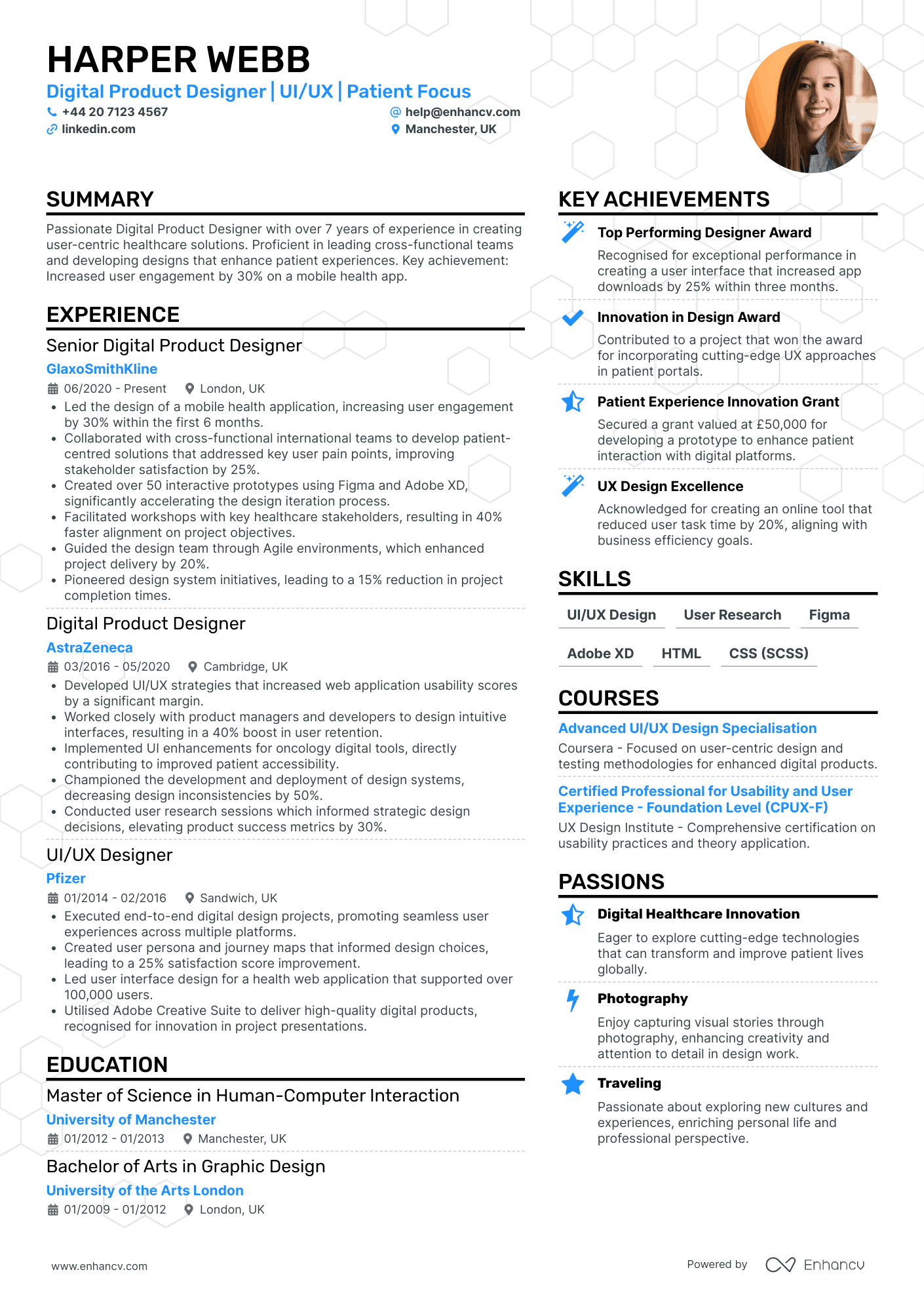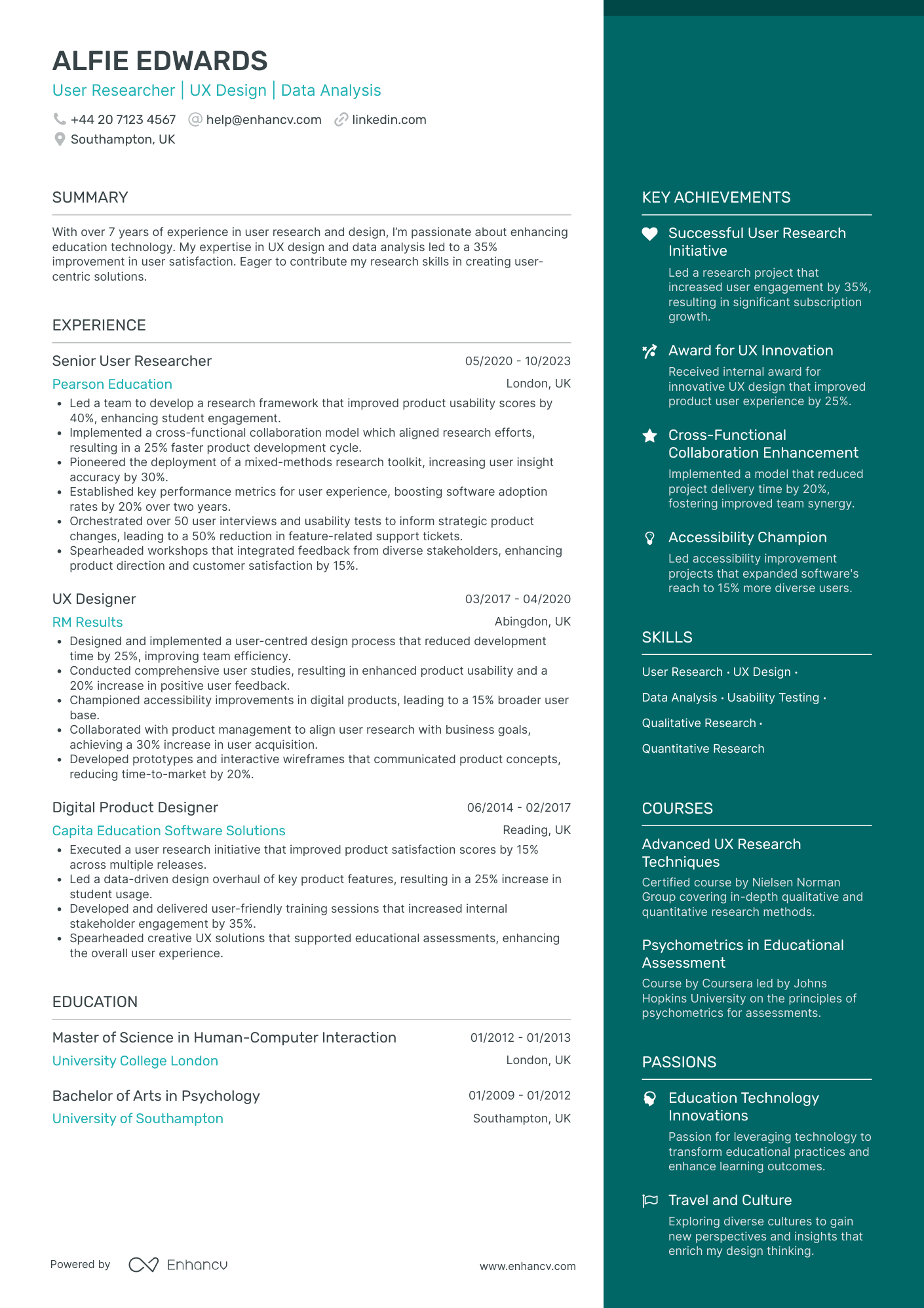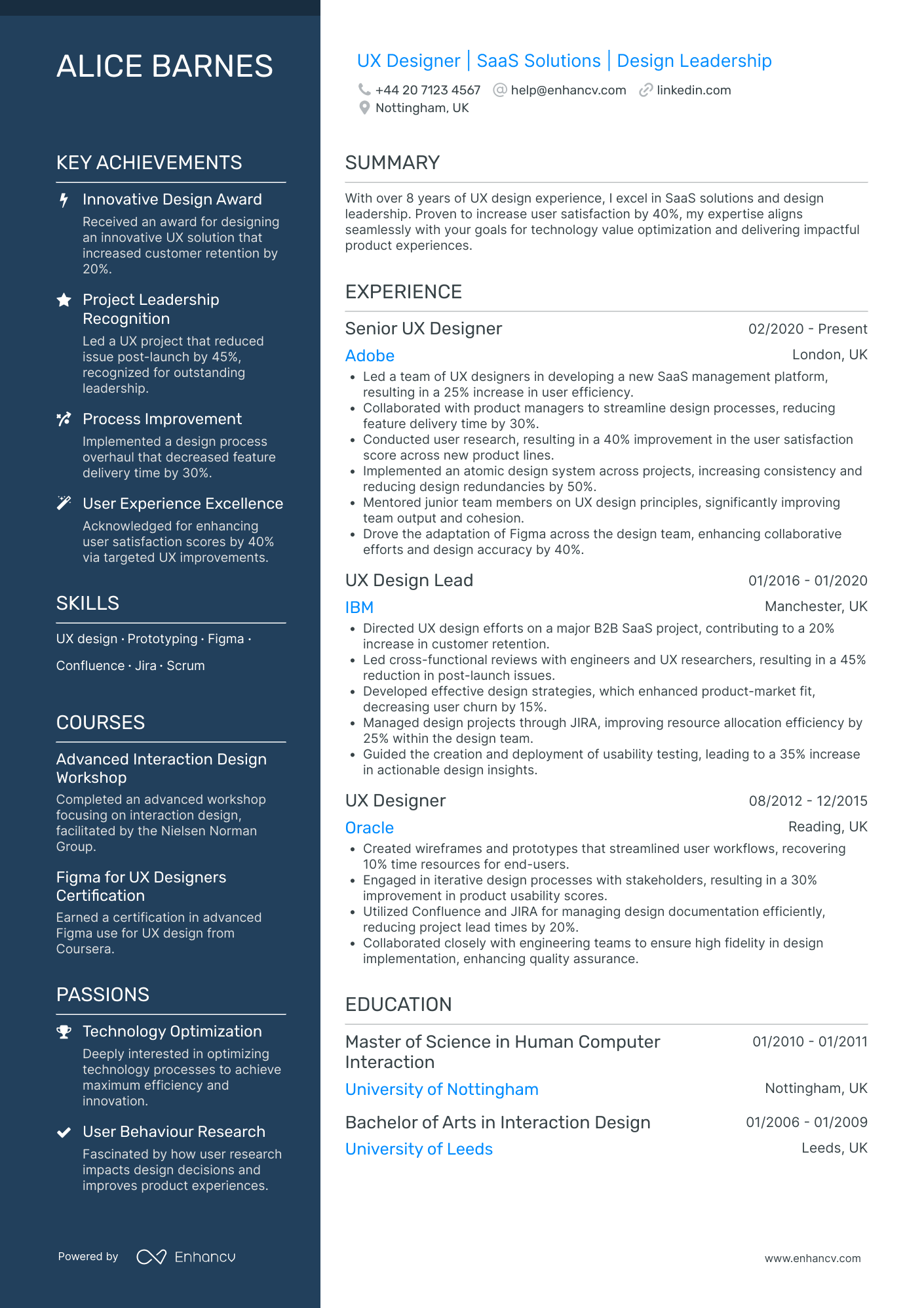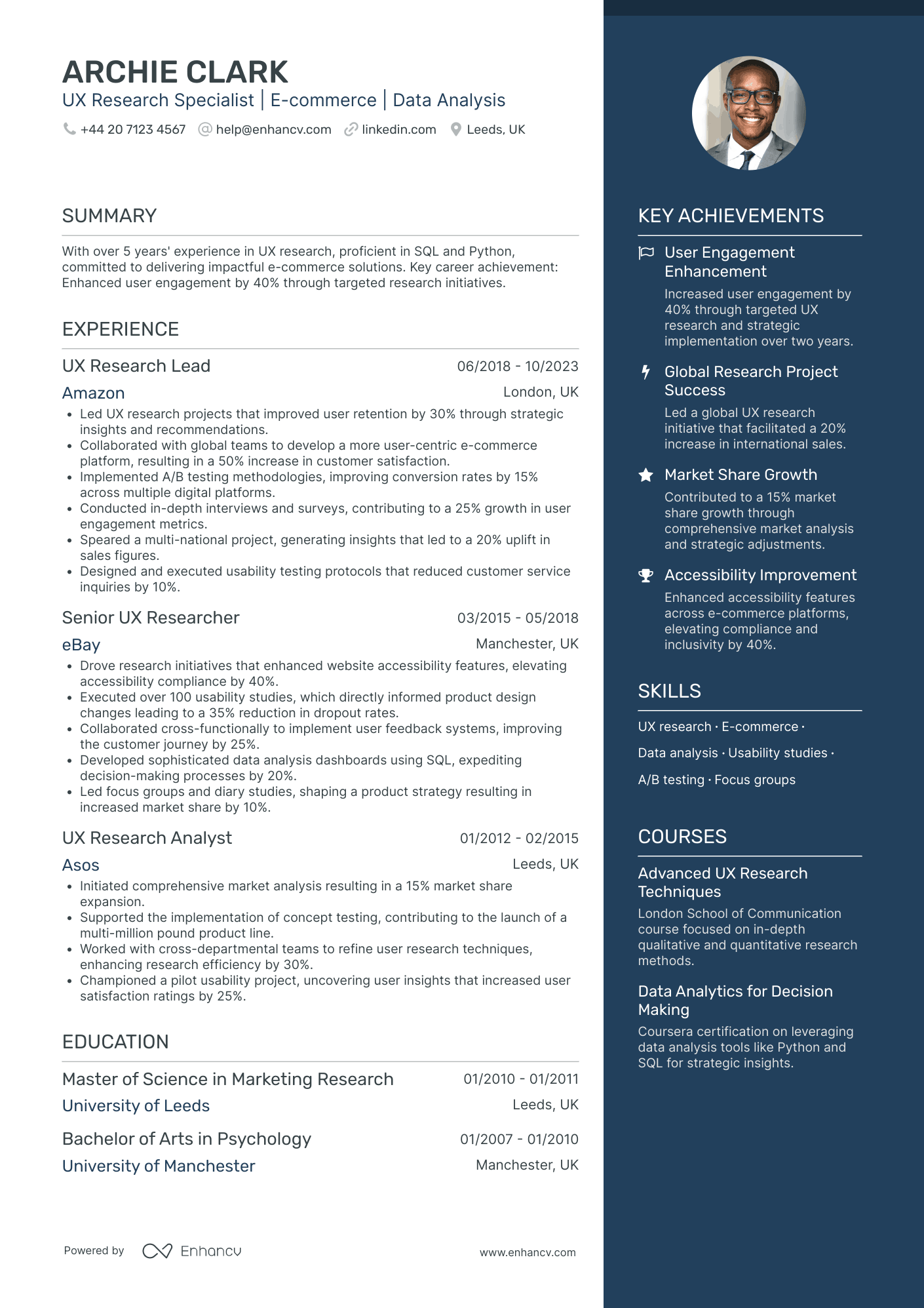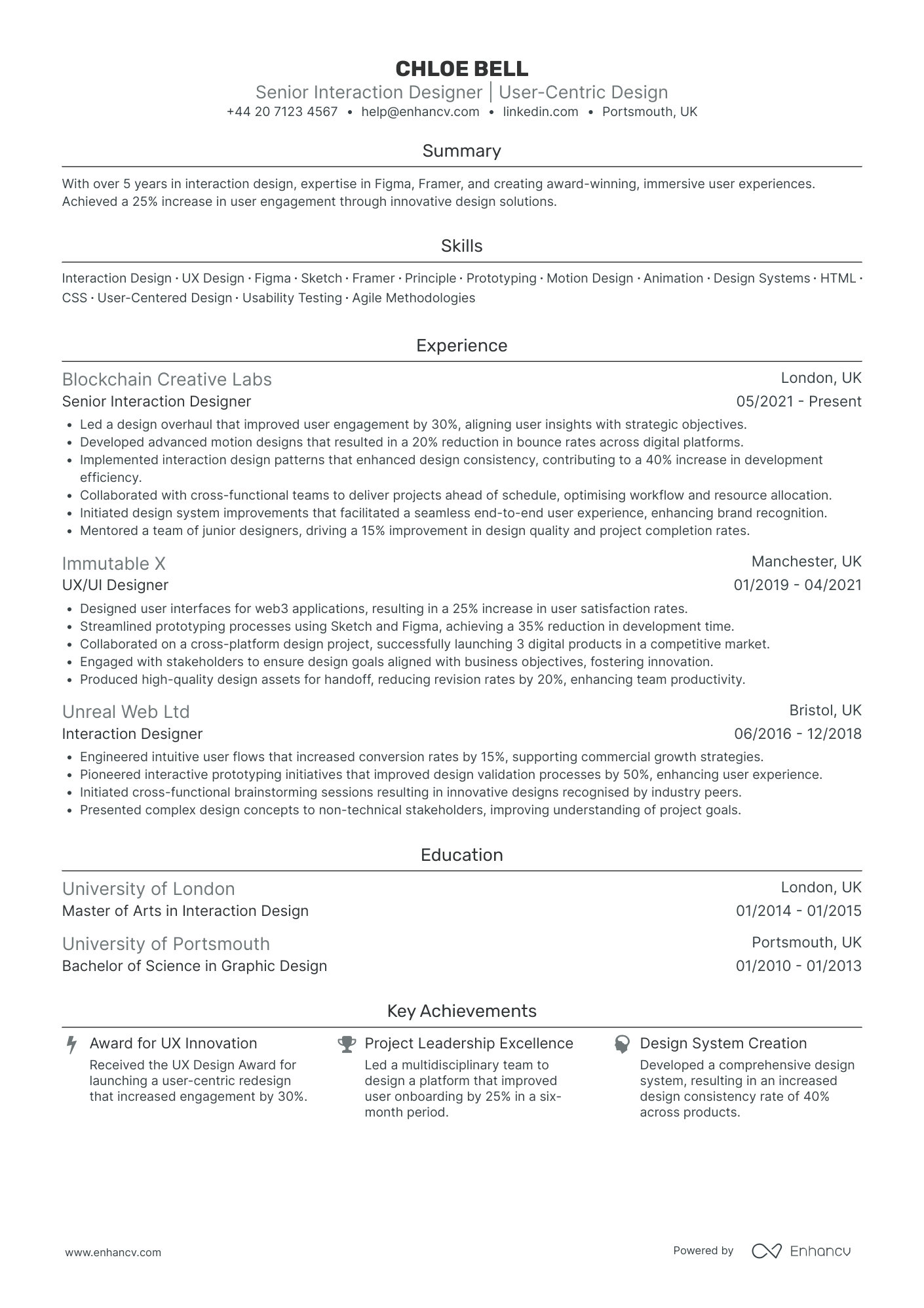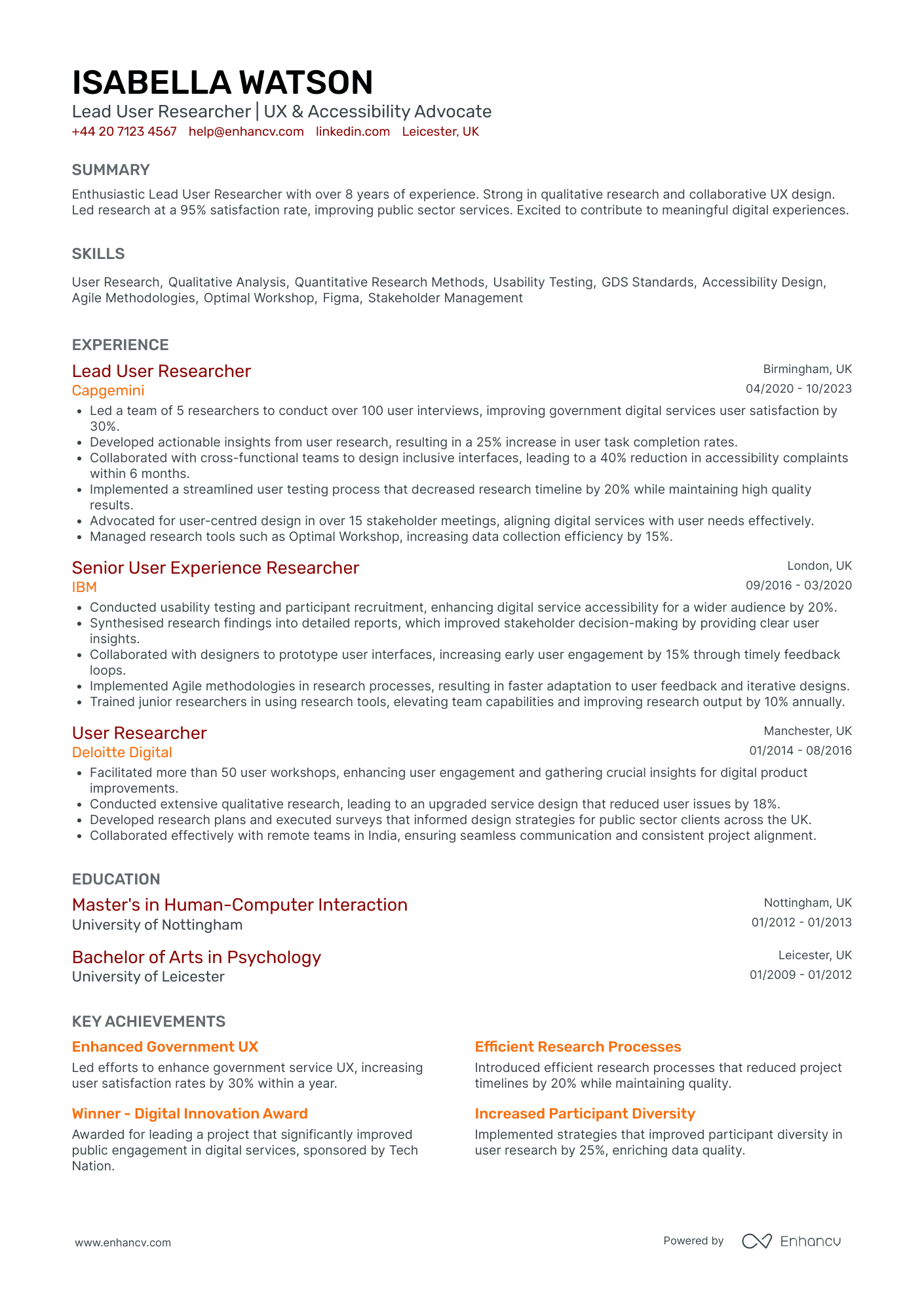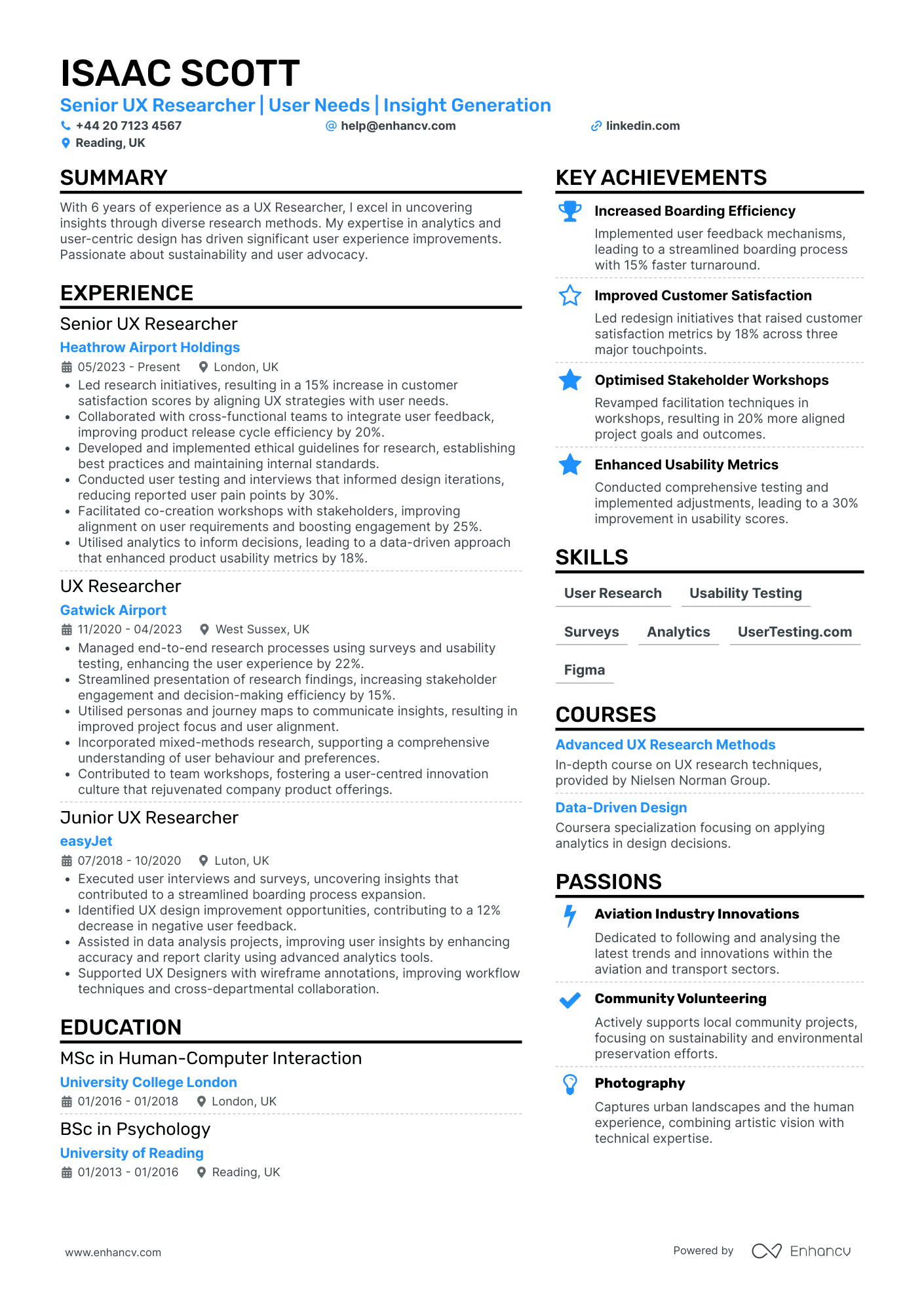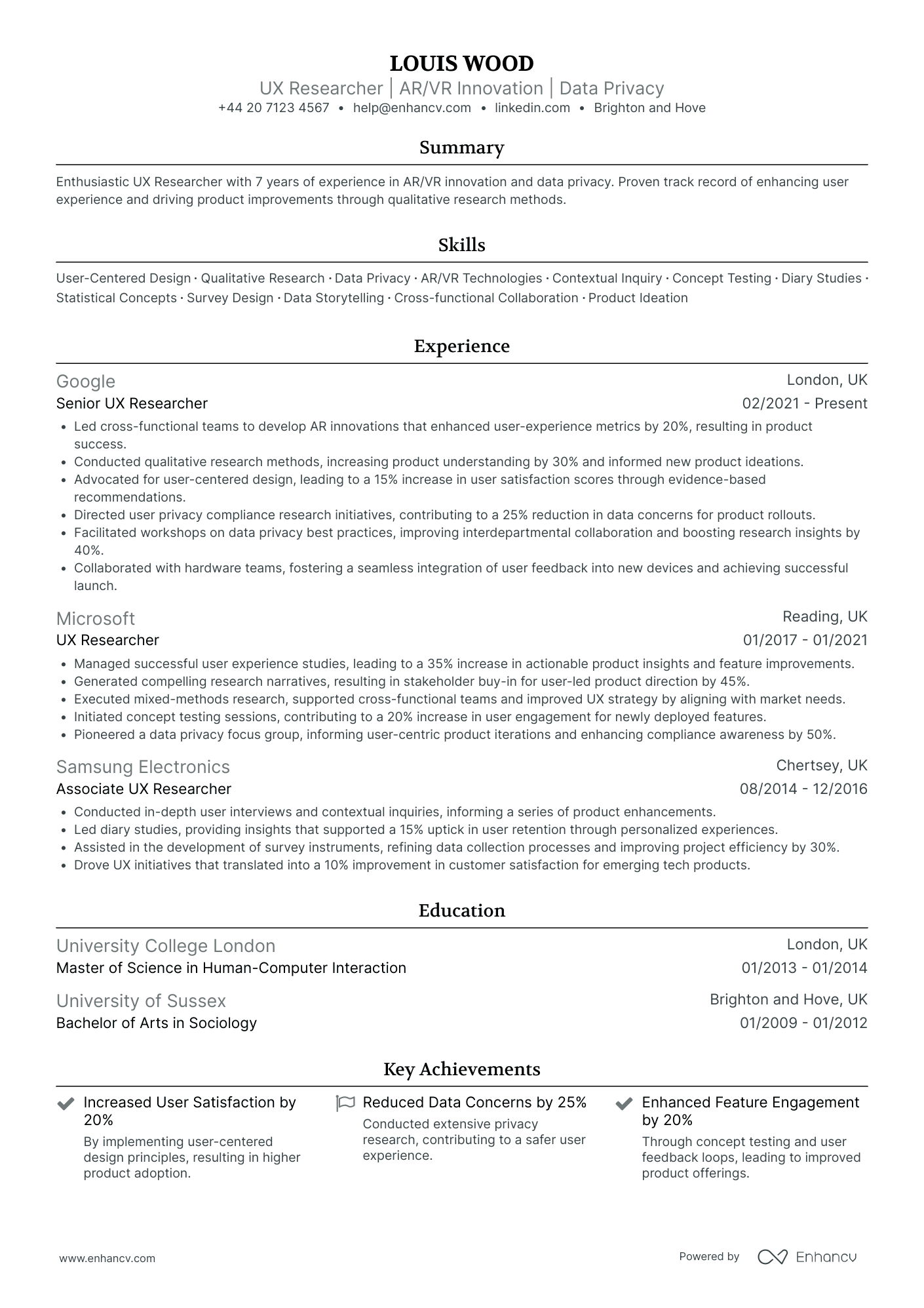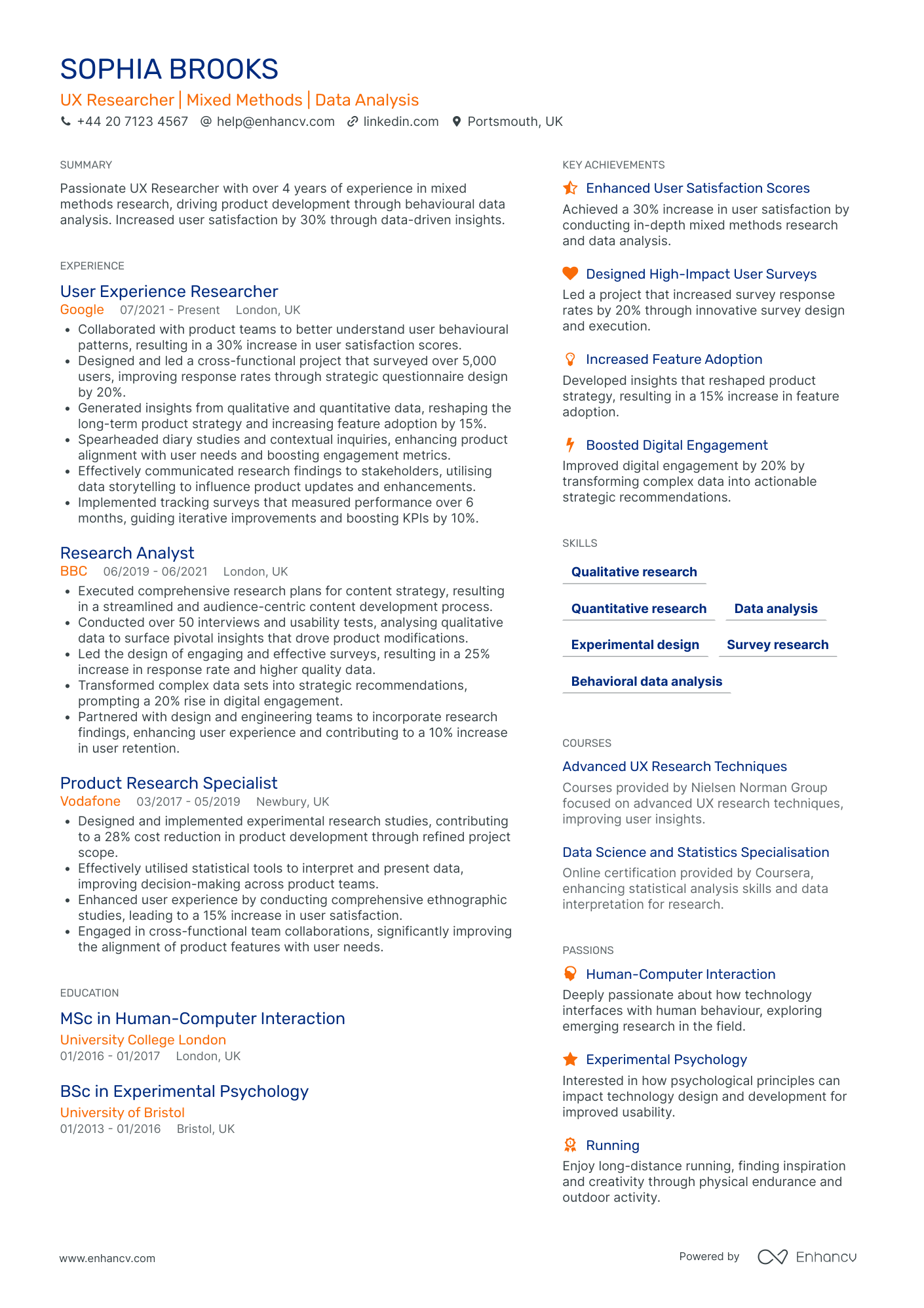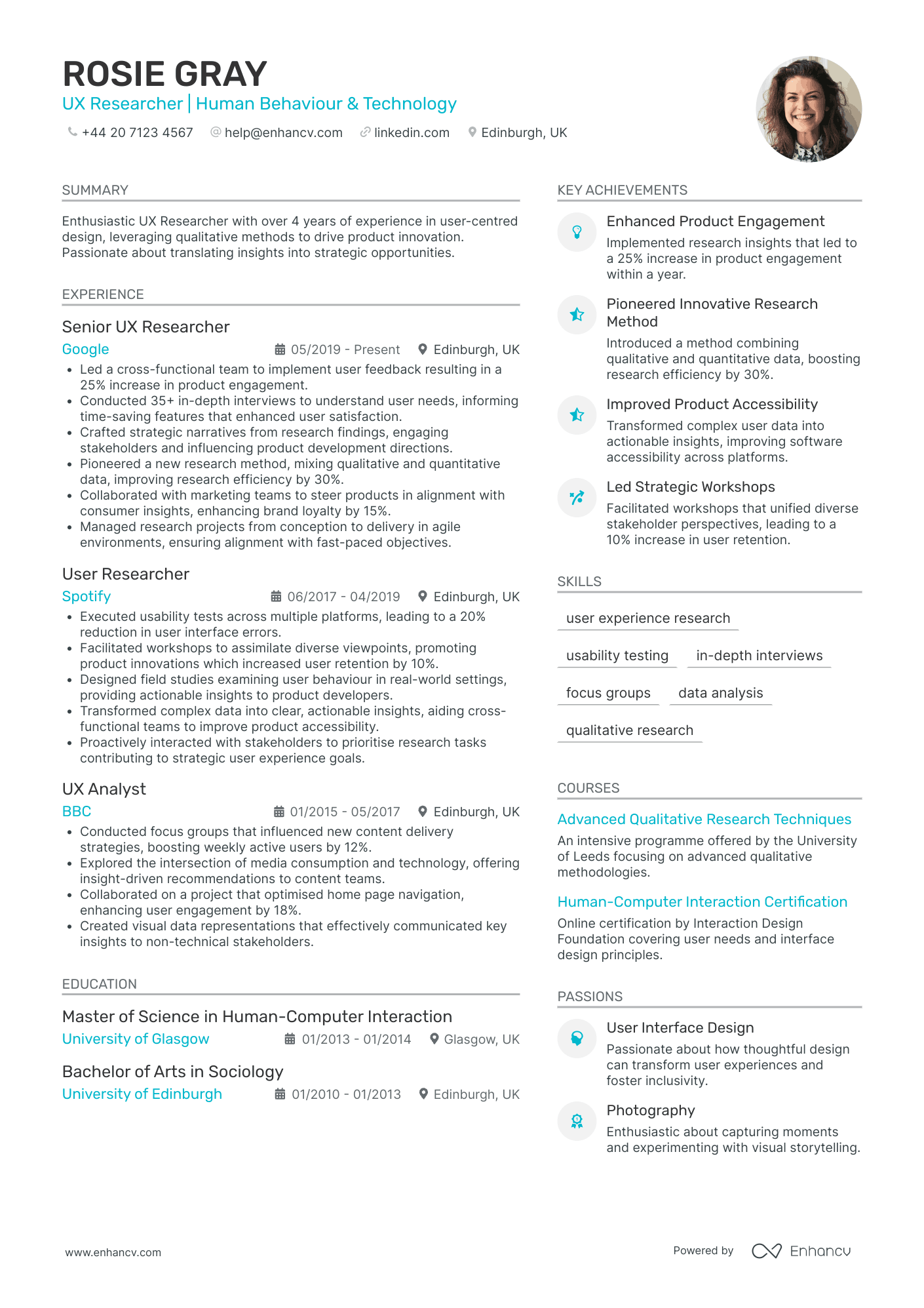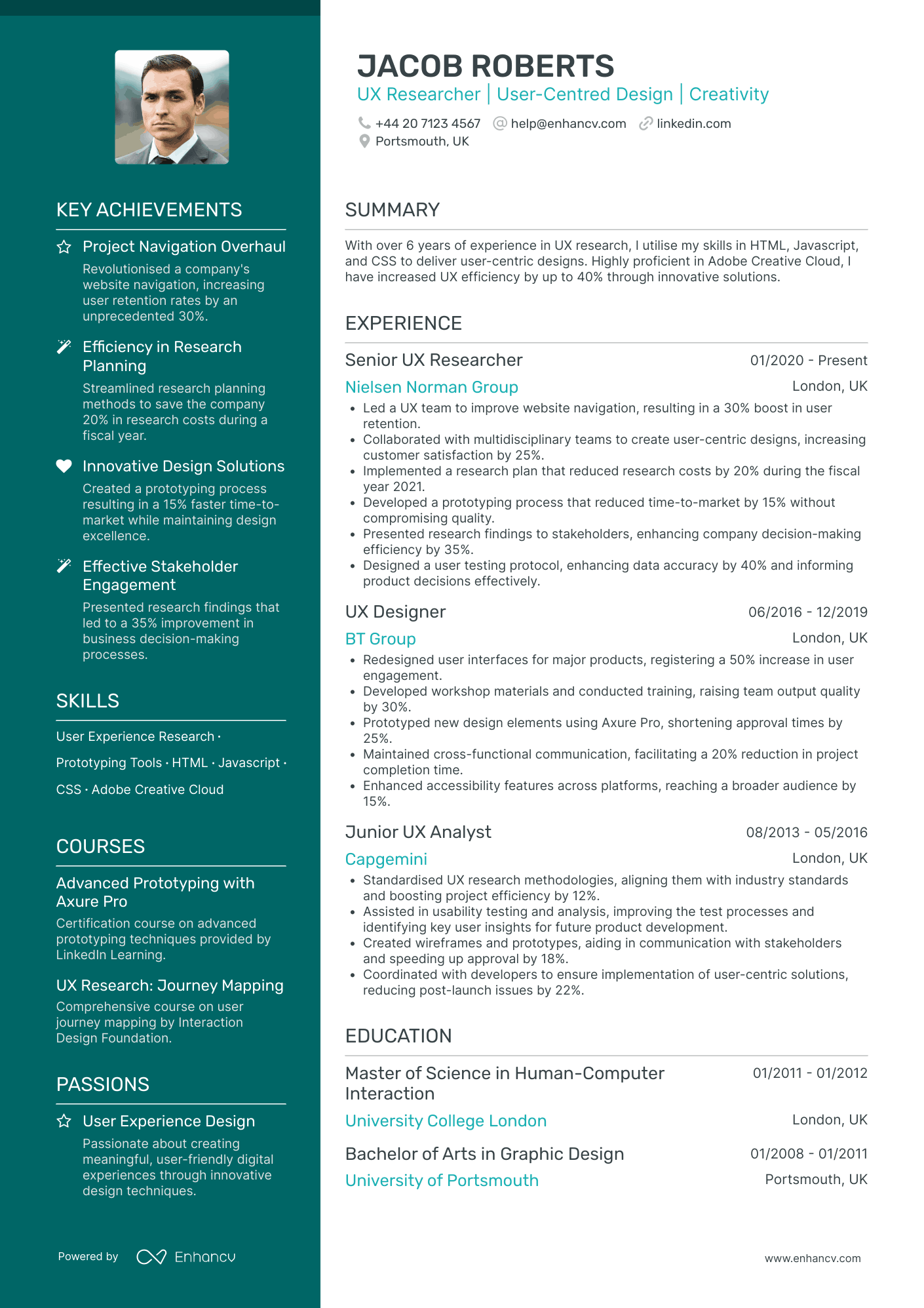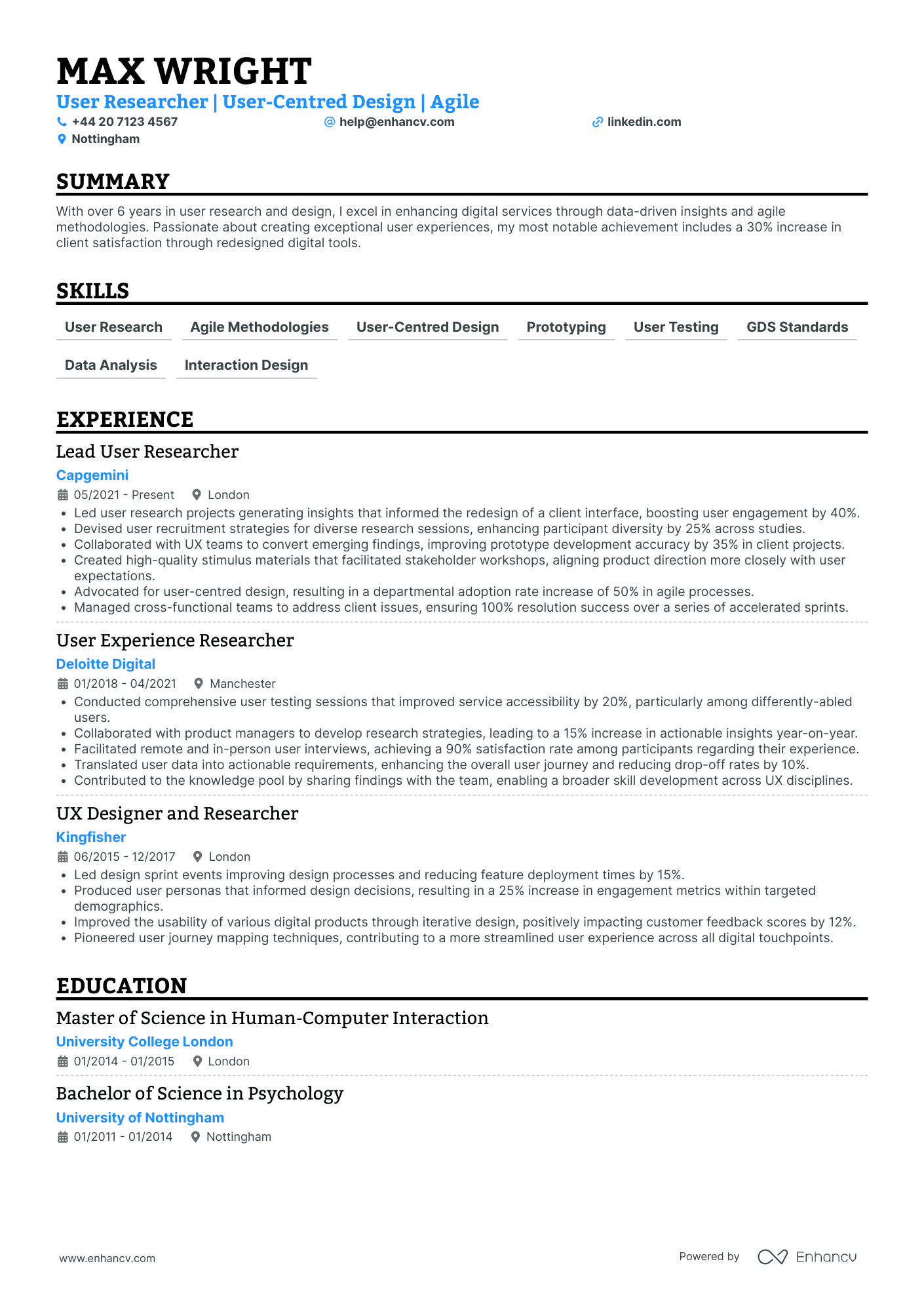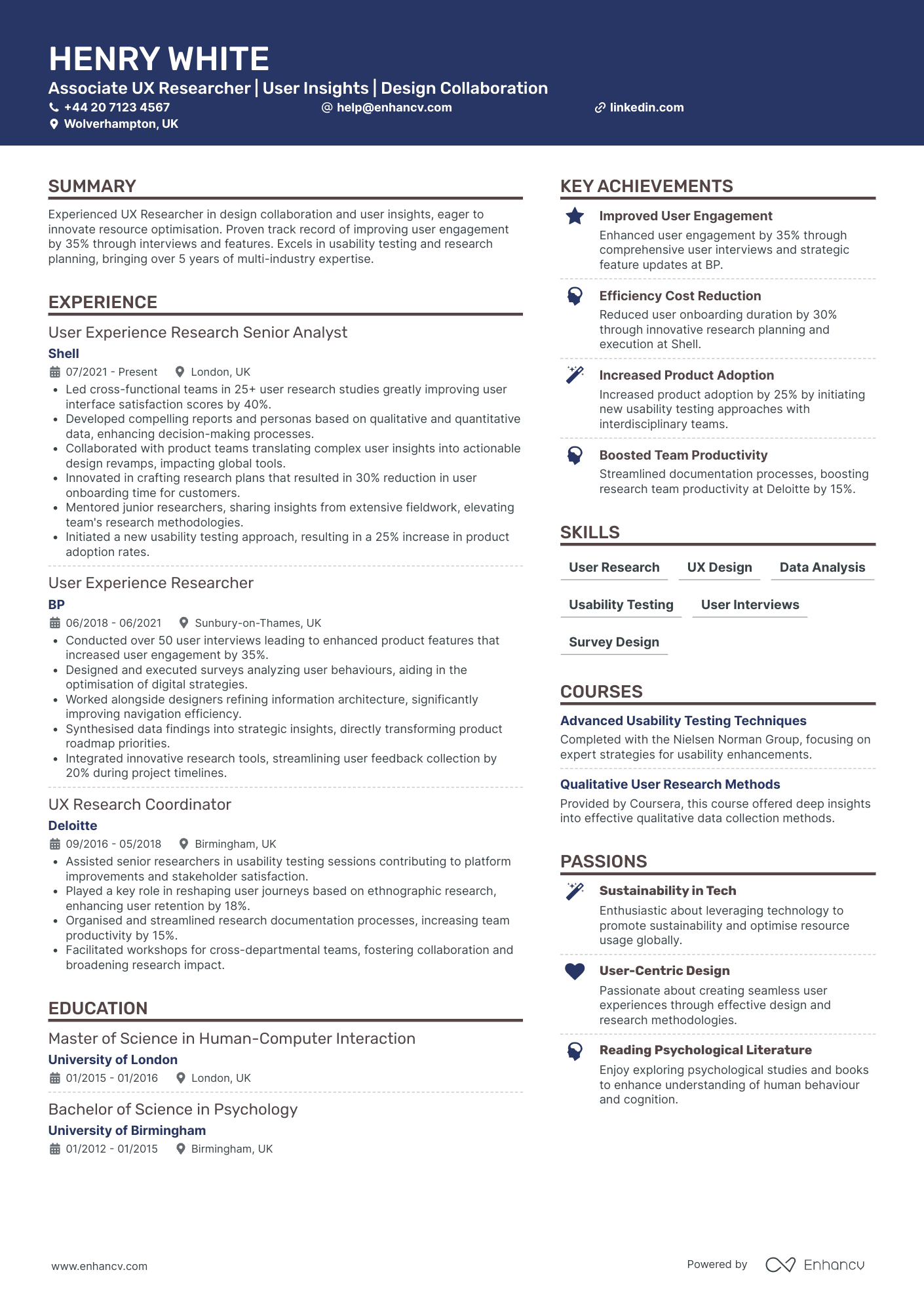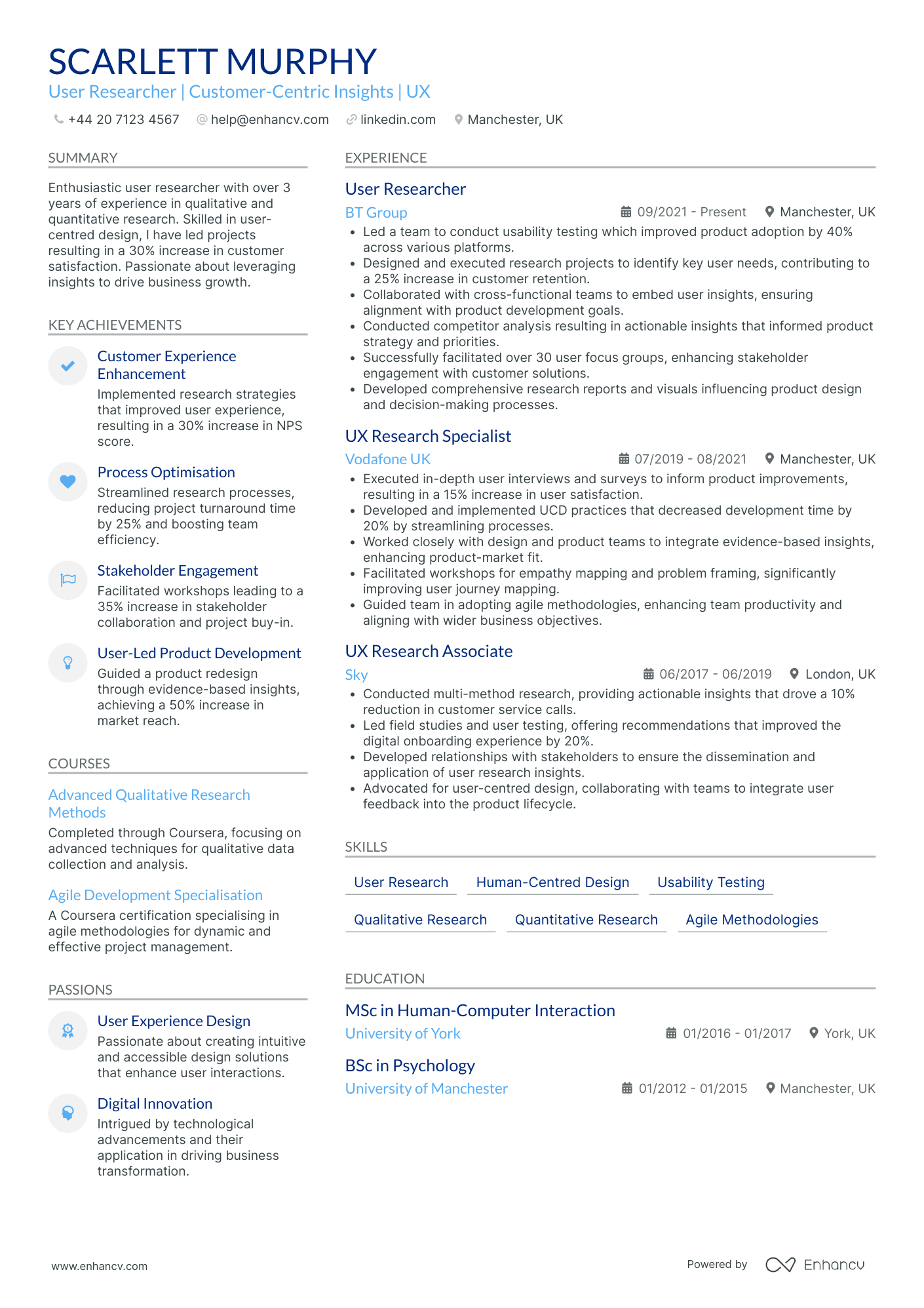One CV challenge you might encounter as a UX researcher is effectively showcasing the breadth of your research methods and their impact on successful project outcomes. Our guide provides tailored tips to help you articulate your diverse skill set and present real-world examples that will demonstrate the tangible value you have delivered in your UX projects.
- Answer job requirements with your ux researcher CV and experience;
- Curate your academic background and certificates, following industry-leading CV examples;
- Select from +10 niche skills to match the ideal candidate profile
- Write a more succinct experience section that consists of all the right details.
Do you need more specific insights into writing your ux researcher CV? Our guides focus on unique insights for each individual role:
CV examples for ux researcher
By Experience
Senior UX Researcher
- Structured and Clear Presentation - The CV is well-organized, presenting sections in a logical order that facilitates quick comprehension. Key elements such as experience, education, skills, and achievements are clearly delineated, making it easy for the reader to understand the candidate’s professional journey and qualifications.
- Progressive Career Development - Ava Phillips demonstrates a clear upward trajectory in her career, moving from a UX Analyst role to Senior User Researcher at prominent companies. Each position holds increasing levels of responsibility and impact, illustrating her commitment to growth and professional development in the UX field.
- Impactful Achievements - The CV highlights significant achievements that transcend mere statistics by emphasizing their implications for business. The reductions in customer complaints, increased user adoption rates, and improved e-commerce conversion rates showcase her ability to utilize UX strategies to deliver robust business outcomes.
Junior UX Researcher
- Impressive Career Progression - Despite starting as a design intern at Ogilvy Health, Leo quickly advanced to a Junior Designer role at Saatchi & Saatchi Wellness. This demonstrates growth within the industry, showcasing his ability to take on increased responsibilities in a short span of time.
- Mastery of Industry-Specific Tools - The CV highlights Leo's proficiency with a wide array of design tools such as Adobe Illustrator, Sketch, and Figma. This technical depth is crucial for a Junior Designer, enabling him to produce high-quality, professional design work and demonstrate adaptability to various project requirements.
- Business Impact Achievements - Leo's achievements are not just about numbers but about tangible business impact. For instance, his work on multi-platform design projects led to a 30% increase in client engagement, and he contributed to a high-value pitch resulting in securing a client worth £500,000 annually. These accomplishments underline his ability to contribute significantly to business objectives through design.
Lead UX Researcher
- Concise Summary of Qualifications - The CV effectively uses the summary section to capture the essence of Harper Webb's expertise in UX research. It highlights over seven years of experience and a recent achievement of increasing user satisfaction by 20%, immediately conveying a strong professional narrative to potential employers.
- Clear Career Progression - Harper Webb’s career trajectory is presented in a way that shows a logical and impressive progression from User Experience Analyst to Lead UX Researcher. Each step is marked by increasing responsibility and leadership roles, reflecting growth and readiness for advanced challenges within the UX field.
- Emphasis on Leadership and Mentorship - The CV underscores soft skills, particularly leadership and mentorship abilities. By detailing the creation of a mentorship program at Barclays and the successful management of a research team at Fidelity International, Harper’s ability to lead and foster a productive team environment comes forth as a central strength.
Principal UX Researcher
- Clear and Concise Content Presentation - The CV is structured in a manner that allows for clear communication of information, with each section clearly delineated and well-organized. Bullet points are used effectively to highlight key accomplishments and responsibilities, providing concise and impactful descriptions that make it easy for a prospective employer to quickly glean valuable insights.
- Dynamic Career Trajectory - Archie Clark has shown a progressive career path with clear growth from a Content Designer at British Airways to a UX Content Designer at the BBC. This advancement is indicative of increasing responsibility and expertise, which speaks to the candidate's ambition and successful accumulation of industry-related skills over time.
- Adaptability and Cross-Functional Collaboration - The CV demonstrates Archie's ability to work across different teams and industries, ranging from aviation with British Airways to media at the BBC, and telecommunications with Sky. This adaptability is underpinned by his experience in collaborating with UX researchers, developers, and stakeholders, showcasing strong interpersonal skills and the ability to deliver on cross-functional projects.
Associate UX Researcher
- Comprehensive and Concise Structure - Olivia Turner’s CV stands out through its clean, structured presentation. Each section is clearly defined, providing essential information efficiently. It avoids unnecessary fluff, concentrating on achievements and skills relevant to a user experience researcher, thus making it quick for hiring managers to locate key information.
- Diverse Industry Experience with Progressive Roles - Olivia's career trajectory illustrates a dynamic growth pattern. Starting as a Market Research Analyst and progressing to an Associate UX Researcher role, the CV reflects a thoughtful career path in diverse yet related domains, showcasing adaptability and a keen interest in advancing through industry shifts.
- Impact-Driven Achievements - The CV emphasizes Olivia’s business-relevant accomplishments, demonstrating their significant impact with metrics like a 15% increase in user satisfaction and a 25% rise in team productivity. Such quantitative results showcase her ability to enact meaningful changes in projects, optimizing processes, and enhancing product usability and team output.
Entry Level UX Researcher
- Clear Content Presentation - Oliver Smith's CV is structured to provide clarity and conciseness, effectively prioritizing relevant information. Key accomplishments and experiences are presented with succinct bullet points, making it easy for the reader to grasp his impact in UX research quickly.
- Career Trajectory Towards Leadership - The progression from an Assistant UX Researcher to a Senior Analyst at notable companies like Mind Candy and the BBC showcases a clear trajectory towards leadership roles. His career path reflects continuous growth and an increasing ability to handle larger, more complex projects.
- Incorporation of Cutting-Edge Tools and Methodologies - Oliver's proficiency in using specialized UX tools such as dscout and User Testing illustrates his technical depth in the field. This, paired with his course work in advanced methods, reflects a commitment to staying at the forefront of UX research technologies and strategies.
By Industry
UX Researcher in Healthcare
- Structured and Focused Layout - The CV is well-organized, featuring clearly defined sections that enhance readability and allow easy navigation through the candidate's qualifications, experience, and skills. Each section is concise, providing relevant details without overwhelming the reader, facilitating quick recognition of Harper Webb's key competencies as a digital product designer.
- Progressive Career Development - Harper demonstrates a remarkable career trajectory, showcasing continual growth with each role taken. The progression from UI/UX Designer at Pfizer to Senior Digital Product Designer at GlaxoSmithKline illustrates their advancement in responsibilities and capabilities within the healthcare industry, signaling both professional development and expertise refinement.
- Emphasis on Industry-Specific Tools and Methodologies - Harper's profile is distinguished by their proficiency in industry-standard design tools and methodologies, such as Figma, Adobe XD, and Agile environments. Their ability to lead cross-functional teams and implement design systems highlights their technical depth and strategic approach to creating innovative patient-centered healthcare solutions.
UX Researcher in Education
- Well-structured content presentation - Alfie Edwards' CV features a coherent structure that effectively presents his career story, enhancing readability. Each section is thoughtfully organized, with concise bullet points that highlight key accomplishments, making it easy for employers to quickly assess his skills and experience. The inclusion of a detailed summary, followed by sections dedicated to professional experience, education, skills, courses, achievements, languages, and passions, ensures comprehensive coverage of his credentials relevant to a User Researcher role.
- Strategic career progression and industry integration - The CV reflects Alfie’s calculated career moves within the education technology sector, showcasing growth from a Digital Product Designer to a Senior User Researcher. His focus on user-centric design and research indicates a clear dedication to improving educational technologies. This targeted career trajectory not only paints a picture of a professional committed to the field but also demonstrates his ability to adapt and grow within a fast-evolving industry.
- Demonstrates impactful achievements - Alfie's accomplishments are measurable and tied to specific business outcomes, which is a standout feature in his CV. For instance, he highlights a 50% reduction in feature-related support tickets and a 20% increase in software adoption rates at Pearson Education. These metrics not only underline his capability to enhance user experiences but also his contribution to operational efficiencies and customer satisfaction, underscoring his value to potential employers in the educational technology sector.
UX Researcher in Finance
- Focused career progression - Alice Barnes presents a coherent career trajectory with consistent growth from a UX Designer at Oracle to a Senior UX Designer at Adobe. Her career path illustrates a clear upward trajectory in leadership roles, aligning perfectly with her title emphasizing design leadership in SaaS solutions.
- Methodological expertise and technical depth - Throughout her career, Alice has demonstrated proficiency in cutting-edge tools and methodologies such as Atomic Design Systems and Figma. This expertise not only signifies her ability to stay relevant in a rapidly evolving industry but also underlines her technical depth crucial for leading UX design efforts.
- Business impact through achievements - The CV highlights significant achievements that underscore Alice’s impact on business metrics. For instance, leading a team at Adobe to develop a new SaaS platform not only increased user efficiency by 25% but also showcased her ability to drive projects that deliver substantial business value.
UX Researcher in E-commerce
- Strategic Presentation and Clarity - The CV excels in structured content presentation, providing clarity and conciseness in showcasing the candidate's capabilities. Each section is systematically organized, beginning with a powerful summary that sets the professional tone, followed by clearly defined experience, education, skills, and achievements. This not only aids readability but also ensures every aspect aligns seamlessly with the role of a UX Research Specialist.
- Impressive Career Trajectory - Archie's career progression is well-documented, highlighting a steady ascent from a UX Research Analyst to a UX Research Lead, indicative of significant professional growth. The trajectory emphasizes not only promotions within the field but also shifts to prominent companies such as Amazon and eBay, depicting a deepening expertise and increasing industry influence, particularly in e-commerce.
- Diverse Industry Tools and Methodologies - A unique element of this CV is the depth of industry-specific tools and methodologies employed. The inclusion of advanced skills in SQL, Python, and A/B testing, complemented by a command of both quantitative and qualitative research methods, underscores a robust technical proficiency. These competencies not only support the candidate's roles but also accentuate their capability to harness data effectively in the dynamic e-commerce landscape.
UX Researcher in Gaming
- Outstanding Leadership and Mentorship - Chloe Bell's CV presents her as not merely a team member but a leader. The experience at Blockchain Creative Labs showcases her role in mentoring junior designers, which led to a 15% improvement in design quality, highlighting her ability to cultivate talent and enhance team performance.
- Comprehensive Skill Set with Modern Tools - The CV details a robust arsenal of design tools, such as Figma, Sketch, Framer, and Principle, which are pivotal in today's interaction design industry. These are complemented by industry-relevant skills like prototyping and motion design, providing evidence of technical depth and a commitment to staying at the forefront of the field.
- Significant Cross-Functional Experience - Chloe’s role in collaborating with cross-functional teams is emphasized, underlining her adaptability in diverse team settings. This capability is vital in her field, enabling seamless integration of design insights with strategic business objectives, thereby ensuring project success and resource optimization.
UX Researcher in Government Services
- Comprehensive Career Growth - Isabella Watson's career trajectory stands out with clear progressions from a User Researcher at Deloitte Digital to a Lead User Researcher at Capgemini. This upward path is marked by significant achievements and leadership roles, showing a continuous elevation in responsibilities and impact within her field.
- Integration of Adaptive Research Methods - The CV highlights Isabella's proficiency in leveraging industry-specific tools such as Optimal Workshop and implementing Agile methodologies, demonstrating her technical depth and adaptability. Her experience in refining research processes and synthesizing qualitative insights is notable for enhancing user experience and accessibility.
- Clear Emphasis on Leadership and Stakeholder Collaboration - Throughout her experience, Isabella has demonstrated exceptional leadership and stakeholder management skills. Leading cross-functional teams, advocating user-centered design, and aligning digital services with user needs underscore her capability to drive collaborative success in strategic projects.
UX Researcher in Automotive
- Exceptional Clarity and Structure - The CV is meticulously organized, with each section clearly defined, making it easy to read and comprehend. The use of bullet points under each job title effectively highlights key achievements and responsibilities, providing a concise yet comprehensive overview of the candidate's experience.
- Significant Career Progression - Isaac Scott demonstrates a clear trajectory of professional growth, moving from a Junior UX Researcher to a Senior UX Researcher position. This progression illustrates an expanding skill set and increasing responsibilities, underscoring the candidate's dedication and ability to excel in the field of UX research.
- Proficiency in Industry Tools and Methodologies - The CV showcases the candidate's adept use of various tools and methodologies relevant to UX research, such as UserTesting.com, Figma, and analytics platforms. This technical depth is crucial in the field, allowing them to implement user insights effectively and enhance user interfaces.
UX Researcher in Non-Profit
- Clear and Strategic Presentation - The CV is structured with clear headers, making it easy to follow the candidate's journey through different roles and achievements. Each section is concise, yet detailed enough to convey depth, utilizing bullet points to succinctly highlight key accomplishments and responsibilities.
- Consistent Career Growth - The progression from Associate UX Researcher to Senior UX Researcher showcases a strong career trajectory within major tech companies. This path reflects increasing responsibilities and expertise in pioneering roles, particularly in AR/VR innovation, indicating a deepening specialization and leadership capability.
- Emphasis on Cross-Functional Leadership - The candidate's experience is rich with examples of cross-functional collaboration, such as leading workshops and integrating user feedback with product teams. This indicates a high adaptability and ability to work effectively across various departments, enhancing the overall product experience.
UX Researcher in Travel and Hospitality
- Clarity and Structured Presentation - The CV is well-organized, presenting information in a clear and concise manner. Each section is neatly separated, making it easy for readers to navigate through Sophia's professional history, educational background, and skills. This logical flow ensures the reader can easily connect the dots between her experiences and her aptitude for UX research.
- Career Growth and Industry Progression - Sophia's career trajectory demonstrates significant growth with notable positions at renowned organizations. Transitioning from a Product Research Specialist at Vodafone to a User Experience Researcher at Google, her path shows progressive responsibility and expertise in her field. The shift from telecommunications to technology giants like Google and BBC indicates adaptability and a willingness to embrace industry shifts.
- Technical Expertise and Methodologies - The CV showcases Sophia's proficiency with industry-specific tools and methodologies such as behavioural data analysis, contextual inquiry, and diary studies. Her skill set is further strengthened by her knowledge of statistical software like SPSS, R, and Stata, which underscores her capability to conduct in-depth quantitative research. This technical depth is crucial for the UX Researcher role, highlighting her ability to generate actionable insights from complex data.
UX Researcher in Telecommunications
- Impressive Career Growth and Industry Variety - Rosie Gray's career trajectory showcases consistent upward movement with roles at reputable tech companies like Google, Spotify, and BBC. Her progression from UX Analyst to Senior UX Researcher illustrates both her professional growth and adaptability across different sectors within the tech industry.
- Diverse Skill Set Enhanced by Specialized Tools and Techniques - The CV highlights Rosie's proficiency with industry-standard tools like Adobe XD and SPSS, combined with her innovative approach to research methodologies such as mixing qualitative and quantitative data. This reflects her technical depth and commitment to advancing her expertise in UX research.
- Strategic Achievements with Substantial Business Impact - Rosie's achievements go beyond just number-driven results; they emphasize strategic influence on product development and user engagement. Her work led to significant increases in product engagement and user retention, showcasing her ability to drive actionable insights and enhance business outcomes through research.
UX Researcher in Real Estate
- Clear and structured presentation - The CV is meticulously organized, leading with essential personal information followed by well-categorized sections covering summary, experience, education, skills, and additional achievements. This clear structure enhances readability and allows quick assimilation of key points, vital for busy recruiters.
- Robust career trajectory - Jacob Roberts demonstrates significant professional growth over the years, beginning as a Junior UX Analyst and advancing to a Senior UX Researcher. Each role showcases a succession of increased responsibilities, aligning well with his expertise in user-centered design and further solidifying his credibility in the field of UX research.
- Strong impact through achievements - Each professional experience section highlights measurable achievements such as a 30% increase in user retention, a 25% rise in customer satisfaction, and a 20% reduction in research costs. These statistics not only quantify success but also emphasize the strategic business impact of his work in UX research and design, reinforcing his value to potential employers.
UX Researcher in Energy
- Clear and well-structured presentation - The CV presents information in a coherent and succinct manner, taking advantage of bullet points to highlight major achievements and responsibilities. Each section is clearly delineated, making it easy for readers to locate specific details and comprehend the candidate's professional history quickly.
- Demonstrates dynamic career progression - Max Wright's career trajectory shows a clear upward movement from a UX Designer and Researcher to a Lead User Researcher, indicating the candidate's growth and recognition in the field. Each role builds on the last, showcasing Max’s expanding expertise and leadership capabilities.
- Emphasis on impactful user-centered design - This CV excels in showcasing specialized skills and methodologies like user-centred design and data analysis, which are central to the role of a User Researcher. Max has successfully used these techniques to drive significant improvements in client satisfaction and user engagement, underscoring their business relevance and demonstrating a strong ability to influence user experience positively.
UX Researcher in Aerospace
- Clear and Structured Content Presentation - The CV uses a clean and organized format, providing a comprehensive overview of Henry White's experience, skills, and achievements. Each section is concisely presented, allowing readers to quickly grasp the key information, enhancing readability and impact.
- Impressive Career Trajectory and Industry Versatility - Henry's career exhibits a consistent upward trajectory, moving from a UX Research Coordinator to a Senior Analyst. This progression indicates strong growth, adaptability, and industry-specific expertise across various sectors such as energy and consulting.
- Proven Impact Through Achievements - The CV effectively highlights Henry's significant achievements across roles, such as a 35% increase in user engagement at BP and a 25% rise in adoption rates through innovative usability approaches at Shell. These metrics underscore the tangible business impact of his contributions.
UX Researcher in Media and Entertainment
- Articulate presentation of user research expertise - The CV excels in outlining Scarlett Murphy's user research capabilities by showcasing experience with prominent companies such as BT Group, Vodafone UK, and Sky. Each role is conveyed with conciseness and clarity, detailing specific procedural responsibilities and the impact of her contributions, effectively highlighting her growth in the user research domain through a structured yet informative manner.
- Demonstration of adaptive career growth - Scarlett's CV illustrates a clear trajectory of career advancement, indicating not only vertical growth through promotions from a UX Research Associate to a User Researcher but also horizontal skill expansion into user-centered design and customer insights. Each position reflects her evolution in responsibility and skillset within the tech industry, evidencing her adaptability and commitment to professional development.
- In-depth industry-relevant methodologies - The CV effectively emphasizes Scarlett's technical prowess in user research. Her talents are accentuated by her use of sophisticated tools and methodologies, such as usability testing, empathy mapping, agile methodologies, and comprehensive research report development. These skills underpin her industry-specific expertise and commitment to deriving actionable insights from complex data sets.
Structuring your ux researcher CV layout: four factors to keep in mind
There are plenty of best practices out there for your CV layout and design. At the end of the day, a clear format and concise CV message should be your top priority. Use your CV design to enhance separate sections, bringing them to the forefront of recruiters' attention. At the same time, you can write content that:
- Follows the reverse chronological order in the experience section by first listing your most recent jobs;
- Incorporates your contact information in the header, but do skip out on the CV photo for roles in the UK;
- Is spotlighted in the most important sections of your CV, e.g. the summary or objective, experience, education, etc. to show just how you meet the job requirements;
- Is no longer than two-pages. Often, the one-page format can be optimal for your ux researcher CV.
Before submitting your CV, you may wonder whether to export it in Doc or PDF. With the PDF format, your information and layout stay intact. This is quite useful when your CV is assessed by the Applicant Tracker System (or the ATS) . The ATS is a software that scans your profile for all relevant information and can easily understand latest study on the ATS , which looks at your CV columns, design, and so much more.

PRO TIP
Be mindful of white space; too much can make the CV look sparse, too little can make it look cluttered. Strive for a balance that makes the document easy on the eyes.

The top sections on a ux researcher CV
- Summary statement showcases your UX philosophy because it sets the tone for your approach and experience.
- Relevant UX research experience lists your job history and helps the recruiter understand your past contributions.
- Key UX research projects highlight your direct involvement in successful studies, showing your practical skills.
- Technical skills and tools section shows your proficiency with specific software and methods essential for UX research.
- Education and certifications demonstrate your foundational knowledge and ongoing professional development in UX.
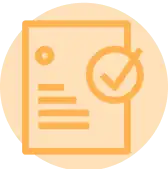
What recruiters value on your CV:
- Emphasise your understanding of diverse research methodologies by detailing the various qualitative and quantitative techniques you have employed in past projects and how they informed design decisions.
- Showcase your ability to translate research findings into actionable insights by providing examples where your recommendations led to user-centred design solutions and improved user experiences.
- Include case studies or portfolio links that display your end-to-end research process, from identifying research questions to executing studies and presenting findings to stakeholders.
- Highlight your collaboration skills by mentioning cross-functional teams you have worked with, such as designers, product managers, and developers, and your role in facilitating a shared understanding of user needs.
- Detail your proficiency with UX research tools (e.g., UserTesting, Optimal Workshop, or Qualtrics) and any relevant certifications or training that align with the latest industry trends and methodologies.
Recommended reads:
Tips and tricks on writing a job-winning ux researcher CV header
The CV header is the space which most recruiters would be referring most often to, in the beginning and end of your application. That is as the CV header includes your contact details, but also a headline and a professional photo. When writing your CV header:
- Double-check your contact details for spelling errors or if you've missed any digits. Also, ensure you've provided your personal details, and not your current work email or telephone number;
- Include your location in the form of the city and country you live in. If you want to be more detailed, you can list your full address to show proximity to your potential work place;
- Don't include your CV photo, if you're applying for roles in the UK or US, as this may bias initial recruiters' assessments;
- Write a professional headline that either integrates the job title, some relevant industry keywords, or your most noteworthy achievement.
In the next part of our guide, we'll provide you with professional CVs that showcase some of the best practices when it comes to writing your headline.

Examples of good CV headlines for ux researcher:
- UX Researcher | Specialising in User-Centred Design | Certified UX Master | 5+ Years of Experience
- Senior UX Researcher | Lead in Mobile App UX | Interaction Design Expert | 10 Years' Insight
- UX Analyst | Voice User Interface Research | HCI Masters | Agile Environments | 8 Years' Expertise
- Junior UX Researcher | Recent Graduate in Cognitive Psychology | UX Certification | Passion for User Testing
- User Experience Specialist | Ph.D. in Human Factors | Advanced Analytics | 12 Years in UX Research
- Principal UX Investigator | Focus on Accessibility | UX Strategy Architect | 15+ Years of Innovation
Choosing your opening statement: a ux researcher CV summary or objective
At the top one third of your CV, you have the chance to make a more personable impression on recruiters by selecting between:
- Summary - or those three to five sentences that you use to show your greatest achievements. Use the CV summary if you happen to have plenty of relevant experience and wish to highlight your greatest successes;
- Objective - provides you with up to five sentences to state your professional aims and mission in the company you're applying for

CV summaries for a ux researcher job:
- With over 5 years of dedicated user experience research, I pride myself on extracting actionable insights, with advanced proficiency in both qualitative and quantitative methodologies including A/B testing and usability studies. Driven by my passion for improving user interfaces, my crowning achievement was leading a redesign that resulted in a 30% uplift in user engagement for a top-tier tech firm.
- Seasoned marketing professional with 8 years in the industry pivoting to UX Research, equipped with a robust analytical skill set, including expertise in customer journey mapping and voice of the customer analysis. My transferable skills were honed by significantly boosting conversion rates by 25% through targeted campaign adjustments at a leading digital agency.
- Accomplished data analyst with a decade of experience seeking to leverage extensive background in data interpretation, statistical analysis, and cognitive psychology to pivot into UX Research. Instrumental in unearthing data trends that improved product offerings, I am eager to apply these skills to enhance user experience design.
- As a fresh graduate with a Master’s degree in Human-Computer Interaction, I am eager to apply my academic knowledge of user-centred design principles and my hands-on experience from university projects to practical challenges in the UX field. My goal is to create intuitive and accessible user experiences that bolster customer satisfaction and loyalty.
- Eager to launch a UX Research career with my strong foundation in psychology and keen eye for user behaviour, I aspire to contribute fresh insights and enthusiasm. Additionally, my academic projects, which included extensive work on user needs analysis, have equipped me to deliver meaningful improvements to user interfaces and overall user satisfaction.
The best formula for your ux researcher CV experience section
The CV experience section is the space where many candidates go wrong by merely listing their work history and duties. Don't do that. Instead, use the job description to better understand what matters most for the role and integrate these keywords across your CV. Thus, you should focus on:
- showcasing your accomplishments to hint that you're results-oriented;
- highlighting your skill set by integrating job keywords, technologies, and transferrable skills in your experience bullets;
- listing your roles in reverse chronological order, starting with the latest and most senior, to hint at how you have grown your career;
- featuring metrics, in the form of percentage, numbers, etc. to make your success more tangible.
When writing each experience bullet, start with a strong, actionable verb, then follow it up with a skill, accomplishment, or metric. Use these professional examples to perfect your CV experience section:

Best practices for your CV's work experience section
- Conducted over 30 usability testing sessions, identifying key user pain points and delivering actionable insights that improved product user interface by 25%.
- Designed and executed ethnographic research studies, resulting in a deep user persona understanding that informed the development of a highly successful mobile application.
- Employed advanced data analysis techniques on large datasets to interpret user behaviour, leading to a data-driven redesign that increased customer satisfaction by 20%.
- Facilitated over 50 workshops with cross-functional teams to integrate user experience research findings effectively into the product development cycle.
- Published 5 articles on UX research methodologies and their impact on design, establishing thought leadership in the UX community.
- Developed and maintained a user research repository that became the cornerstone for all user centric design decisions in the organisation.
- Implemented A/B testing frameworks that optimised the conversion rates of key user flows by up to 15%.
- Collaborated with product managers and designers to incorporate user feedback into product roadmaps, ensuring user needs were prioritised.
- Managed the recruitment and onboarding of user research participants, ensuring a diverse and representative sample for our studies.
- Conducted over 50 in-depth user interviews and usability testing sessions to identify core user needs, enhancing product satisfaction by 30%.
- Designed and executed A/B testing for a suite of mobile applications, leading to a 15% increase in user engagement metrics.
- Collaborated with interdisciplinary teams to translate business goals into actionable research agendas, directly contributing to 5 major product releases.
- Pioneered a cross-platform user experience framework that was adopted company-wide, improving consistency across digital touchpoints.
- Facilitated over 30 stakeholder workshops to define user personas and scenarios, effectively aligning product development with user-centric strategies.
- Managed a team of junior UX researchers, mentoring them in qualitative and quantitative research methodologies and fostering a collaborative team environment.
- Spearheaded the development of an internal user testing lab, reducing outsourcing costs by 20% while increasing testing availability.
- Implemented a company-wide feedback loop with customers, gathering over 10,000 data points that informed iterative design processes.
- Applied ethnographic research techniques to uncover unmet user needs, which led to the development of two innovative product features.
- Coordinated with UI designers to overhaul the user experience for a major e-commerce platform, resulting in a 25% increase in conversion rates.
- Conducted heuristic evaluations and cognitive walkthroughs for pre-release software, identifying key areas for improvement that reduced user error rates by 10%.
- Authored a comprehensive UX research best practices guide used by all departments, promoting a company-wide understanding of user-centred design principles.
- Orchestrated large-scale remote usability studies for global product launches, which informed localisation strategies for 5 different markets.
- Integrated biometric research methods into user testing sessions, providing richer insights into user emotional states and improving empathy in design decisions.
- Presented research findings to executive leadership teams, influencing the prioritisation of feature development within the product roadmap.
- Streamlined the user interview process using a new digital toolkit, which cut down the research cycle time by 40%, enabling quicker design iterations.
- Led a research project targeting underserved user segments, which uncovered opportunities for market expansion and led to a 20% revenue growth in that demographic.
- Crafted and maintained a living document of user journey maps, which became a central reference for cross-functional team discussions and strategic planning.
- Developed and rolled out a comprehensive user experience questionnaire for post-launch product feedback, capturing insights from over 5,000 users.
- Partnered with product managers to integrate user research findings into sprint planning sessions, shortening feature development cycles by 15%.
- Initiated a quarterly research insights report, providing actionable recommendations that influenced the iteration of core product features.
- Led the user research for a new VR platform, which informed interface designs that have been praised for their intuitive user flow.
- Developed a user feedback repository that centralized all user data, which became instrumental in decision-making processes for the user experience team.
- Generated comprehensive competitive analysis reports, which were leveraged by the product team to identify market gaps and opportunities.
Writing your CV without professional experience for your first job or when switching industries
There comes a day, when applying for a job, you happen to have no relevant experience, whatsoever. Yet, you're keen on putting your name in the hat. What should you do? Candidates who part-time experience , internships, and volunteer work.
Recommended reads:

PRO TIP
Describe how each job helped you grow or learn something new, showing a continuous development path in your career.
The CV skills' divide: between hard and soft skills
Of course, you may have read the job requirements plenty of times now, but it's key to note that there is a difference between technical and personal skills. Both are equally relevant to your job application. When writing about your skill set, ensure you've copy-pasted the precise skill from the job requirement. This would not only help you ensure you have the correct spelling, but also pass any Applicant Tracker System (ATS) assessments.
- Hard skills show your technological capabilities. Or whether you'll be a good technical fit to the organisation. Ensure you've spotlighted your hard skills in various sections of your CV (e.g. skills section, projects, experience) by including the technology and what you've attained;
- Soft skills pinpoint your personality and people or communication skills, hinting at if you'll easily accomodate into the team or organisation. Quantify your soft skills in your CV achievements, strengths, summary/objective, and experience sections. Always support your soft skills with how they've helped you grow as a professional.
Top skills for your ux researcher CV:
User-Centred Design Principles
Usability Testing
Qualitative Research
Quantitative Research
User Interviewing Techniques
Survey & Questionnaire Design
Data Analysis & Statistics
A/B Testing
Prototyping & Wireframing
UX Design Tools Proficiency
Analytical Thinking
Empathy
Communication
Collaboration
Problem-Solving
Adaptability
Organisation
Critical Thinking
Attention to Detail
Active Listening

PRO TIP
If you have received professional endorsements or recommendations for certain skills, especially on platforms like LinkedIn, mention these to add credibility.
Your university degree and certificates: an integral part of your ux researcher CV
Let's take you back to your uni days and decide what information will be relevant for your ux researcher CV. Once more, when discussing your higher education, select only information that is pertinent to the job (e.g. degrees and projects in the same industry, etc.). Ultimately, you should:
- List only your higher education degrees, alongside start and graduation dates, and the university name;
- Include that you obtained a first degree for diplomas that are relevant to the role, and you believe will impress recruiters;
- Showcase relevant coursework, projects, or publications, if you happen to have less experience or will need to fill in gaps in your professional history.

PRO TIP
Focus on describing skills in the context of the outcomes they’ve helped you achieve, linking them directly to tangible results or successes in your career.
Recommended reads:
Key takeaways
Your successful job application depends on how you well you have aligned your ux researcher CV to the job description and portrayed your best skills and traits. Make sure to:
- Select your CV format, so that it ensures your experience is easy to read and understand;
- Include your professional contact details and a link to your portfolio, so that recruiters can easily get in touch with you and preview your work;
- Write a CV summary if you happen to have more relevant professional experience. Meanwhile, use the objective to showcase your career dreams and ambitions;
- In your CV experience section bullets, back up your individual skills and responsibilities with tangible achievements;
- Have a healthy balance between hard and soft skills to answer the job requirements and hint at your unique professional value.
